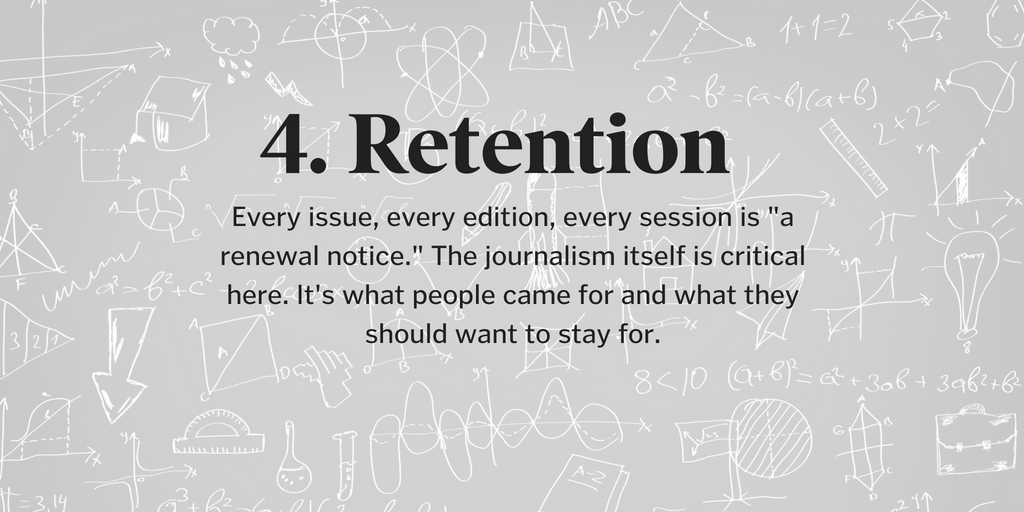Last week we introduced several alternatives to the funnel, the concept of turning casual audiences into loyal ones (aka members or subscribers, who support the survival of the journalism.)
A lot of you liked the waterslide/waterpark concept. It shows there are different paths with one goal — retention.
Gwen Vargo, director of reader revenue at the American Press Institute, doesn’t have a better term. But like a lot of people, she’s not crazy about “funnel.”
“I think it implies that gravity is helping the process, and it’s not,” she said. “If anything, it should be flipped. It’s harder to go up the funnel.”
Vargo agreed with News Media Alliance’s Rebecca Frank on another problem with the funnel: how does it account for retention? A lot of effort goes into getting people to become subscribers. But what about keeping them?
“Subscriber and member retention is where your long-term revenue is,” Vargo said.
OK, so let’s agree to call it the funnel* for now. What work actually goes into each level? Vargo broke it down into four sections: Awareness, Engagement, Conversion and Retention. Let’s go through them one by one.

Awareness, or audience, isn't about traffic or pageviews, Vargo said. It’s where people are first engaging with your journalism. Maybe it’s through social media, an event or a newsletter.
Newsrooms can play a big role in the funnel* in this first level by using social media to reach and engage with people and build communities. They can also anchor newsletter and subscription offers in articles to make sure people know there's more that might interest them.
API’s study on the different paths to subscription found that one path includes “topic hunters,” or people who are dedicated to a topic. From the report:
As they become engaged with coverage of a topic, they are more likely to follow individual journalists who cover this topic on social media.
They often convert to subscribing by becoming so engaged that they hit a paywall meter limit, and they are more likely than others to have encountered an article that impresses them so much they decide to subscribe. After subscribing, they are highly likely to share those stories on social media.
People interact with journalism for a long time before they become subscribers, Vargo said. So there are a lot of chances at this level to make an impact. It’s not just up to marketing.
“It’s an ongoing process to nurture the relationship.”

If subscriptions and memberships are long-term relationships, this is where those relationships start to get a bit more serious.
This is where things like analytics (how often someone visits a site, how recently and how much time they spend on the site), engagement with journalists, event attendance and content sharing matters, Vargo said.
Some newsrooms that have developed this data have created digital user scores that help the newsroom understand different kinds of audiences.
And it’s another good place for the journalism to make its case. Editorial newsletters are big on this level and a great way to test new work and give journalists a voice.

“This is where paywalls can come in,” Vargo said, as well as calls to action on the site.
This is where the news organization has to put thought into the subscription or membership offer itself. How is it priced or bundled? How is it presented? Are landing pages optimized?
“That’s a wonky thing to say,” Vargo said, “but you want to make sure the pages are streamlined, that it’s clean and it’s easy.”
Are there multiple ways to register and pay? That makes it much easier to get through the process, Vargo said.
“I think this is also a place for the newsroom and the business side to work together,” she said.
For newsrooms that have dynamic paywalls, this is the place for a conversation about the kind of work that gets conversions quickly and the kind that takes time to cultivate.
“This part of the tier is probably one of the more tactical, technical, digital marketing pieces,” she said. “This is more the science of marketing, but still very important.”

After people subscribe, how are they welcomed? Vargo asked.
“I always found it important to reach out to the subscriber and not ask for money.”
There’s business side work here, including working to move people from monthly to annual subscriptions. There’s technical side work, too, in making sure that there’s a good system for updating account information if people auto-renew. That stuff is less sexy, Vargo said, but critical.
And then there’s the journalism.
Vargo heard a statistic once that getting someone to subscribe is 80 percent about the offer and 20 percent about the content. Once they are subscribed, however, that flips.
Whatever you want to call it, the process itself involves (and relies on) the journalism. Once newsrooms “see themselves in the process, that ties everything together and everything is aligned around this process. We’re not chasing pageviews anymore,” she said. "Newsrooms didn’t like that anyway.”
Next week, we're going to talk with a local news subscriber about why they subscribed. (I'm still looking for someone, so if you have a suggestion, please let me know.)
In the meantime, I have a lot to share this week: You have a bit of time left to sign up for the Community Listening and Engagement Fund. The Center for Cooperative Media has a new newsletter to help you localize national news. Membership Puzzle's member manifesto seems like it's just good for everyone. Here's Rusty Coats on why local news doesn't need to be saved. The Solutions Journalism Network is giving out grants to local reporters. It's time to sign up for ONA Local's 2018 summit. And, if you want to talk more about all the things we talk about in this newsletter, come hang out with me in this webinar series on Lessons from Local. It starts soon! I'm not nervous! I swear!
See you next week!
*Until we can agree on a better term.







